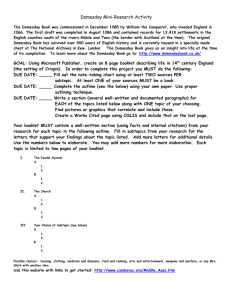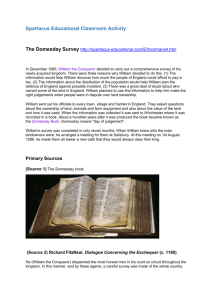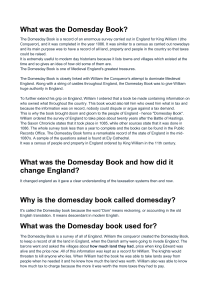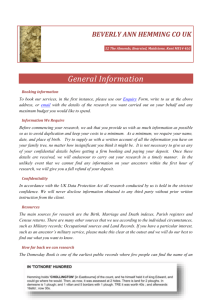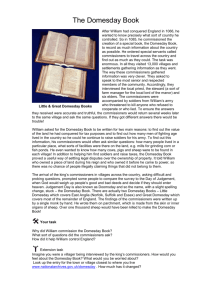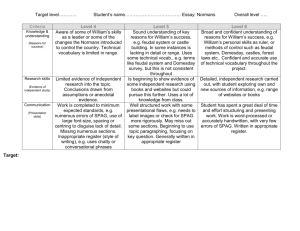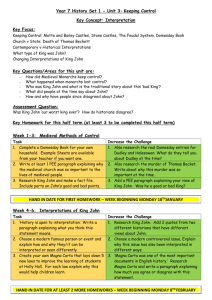The Domesday Book
advertisement
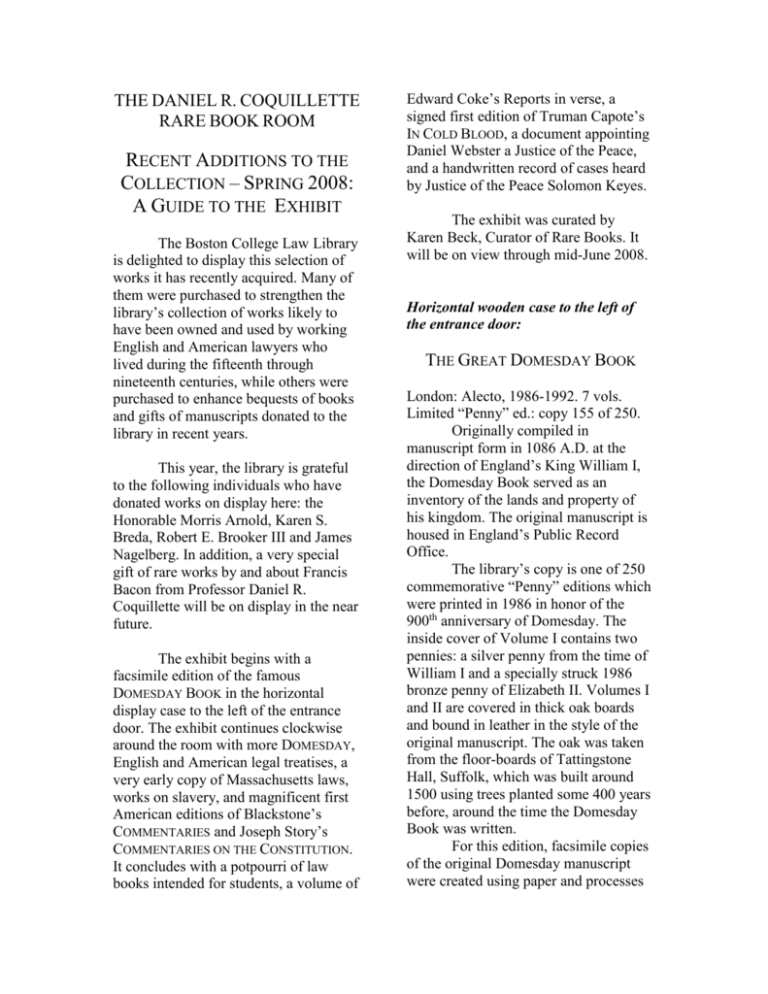
THE DANIEL R. COQUILLETTE RARE BOOK ROOM RECENT ADDITIONS TO THE COLLECTION – SPRING 2008: A GUIDE TO THE EXHIBIT The Boston College Law Library is delighted to display this selection of works it has recently acquired. Many of them were purchased to strengthen the library’s collection of works likely to have been owned and used by working English and American lawyers who lived during the fifteenth through nineteenth centuries, while others were purchased to enhance bequests of books and gifts of manuscripts donated to the library in recent years. This year, the library is grateful to the following individuals who have donated works on display here: the Honorable Morris Arnold, Karen S. Breda, Robert E. Brooker III and James Nagelberg. In addition, a very special gift of rare works by and about Francis Bacon from Professor Daniel R. Coquillette will be on display in the near future. The exhibit begins with a facsimile edition of the famous DOMESDAY BOOK in the horizontal display case to the left of the entrance door. The exhibit continues clockwise around the room with more DOMESDAY, English and American legal treatises, a very early copy of Massachusetts laws, works on slavery, and magnificent first American editions of Blackstone’s COMMENTARIES and Joseph Story’s COMMENTARIES ON THE CONSTITUTION. It concludes with a potpourri of law books intended for students, a volume of Edward Coke’s Reports in verse, a signed first edition of Truman Capote’s IN COLD BLOOD, a document appointing Daniel Webster a Justice of the Peace, and a handwritten record of cases heard by Justice of the Peace Solomon Keyes. The exhibit was curated by Karen Beck, Curator of Rare Books. It will be on view through mid-June 2008. Horizontal wooden case to the left of the entrance door: THE GREAT DOMESDAY BOOK London: Alecto, 1986-1992. 7 vols. Limited “Penny” ed.: copy 155 of 250. Originally compiled in manuscript form in 1086 A.D. at the direction of England’s King William I, the Domesday Book served as an inventory of the lands and property of his kingdom. The original manuscript is housed in England’s Public Record Office. The library’s copy is one of 250 commemorative “Penny” editions which were printed in 1986 in honor of the 900th anniversary of Domesday. The inside cover of Volume I contains two pennies: a silver penny from the time of William I and a specially struck 1986 bronze penny of Elizabeth II. Volumes I and II are covered in thick oak boards and bound in leather in the style of the original manuscript. The oak was taken from the floor-boards of Tattingstone Hall, Suffolk, which was built around 1500 using trees planted some 400 years before, around the time the Domesday Book was written. For this edition, facsimile copies of the original Domesday manuscript were created using paper and processes which closely recreated the look of the original handwritten vellum (sheepskin) manuscript. project. It was in their interest as well as the king’s to have a clear statement of their own wealth and rights, especially since many of them had only recently acquired title to their lands. The book came to be known as the “Domesday Book” to call to mind the day of judgment. A twelfth-century writer explained: “For just as the sentence of that strict and terrible Last Judgement cannot be evaded by art or subterfuge so, when a dispute arises in this realm concerning facts which are there written down and an appeal is made to the book itself the evidence it gives cannot be set at naught or evaded with impunity.” HOW DOMESDAY WAS COMPILED The anonymous chronicler who contributed an account of King William’s reign to the Anglo-Saxon Chronicle described the creation of Domesday as follows: “[William] sent his men over all England into every shire and had them find out how many hundred hides there were in the shire or what land and cattle the king had himself in the country, or what dues he ought to have in twelve months from the shire. Also he had a record made of how much land the archbishops had, and his bishops and his abbots and his earls – and though I relate it at too great length – what or how much everybody had who was occupying land in England, in land and cattle and how much money it was worth. So very narrowly did he have it investigated, that there was no single hide nor virgate of land, not indeed (it is a shame to relate though it seemed to him no shame to do) one ox not one cow not one pig which was there left out, and not put down in his record; and all these records were brought to him afterwards.” HOW TO USE THE DOMESDAY BOOK This edition of Domesday consists of many parts. The exhibit in these three cases shows how the parts work together. (1) This case contains one of the two facsimile volumes (written in Latin) and one of the two modern English translation volumes in this set. Both books are opened to the page on which the inventory of the county of Surrey (called “Sudrie” in William’s time) begins. The inventory commences with a list of the landholders in Surrey in order of importance, beginning with King William and the Archbishop of Canterbury and ending with various clerks and a crossbow-man. On the following pages each landholder’s real property, livestock, and other items of value are described. → WHY DOMESDAY WAS COMPILED In 1066, the Norman Conquest swept William I (also known as William the Conqueror) into power in England. Not surprisingly, he needed a complete and accurate record of the contents of his kingdom for tax purposes, so that he would know which taxes he might expect from each town and landholder, and which new taxes he might be able to levy. But Domesday was more than that. Domesday scholars note that the landowners cooperated in the Domesday 2 “Surrey” portion of the Domesday Book on exhibit in the first case. People are listed by name and by occupation, e.g. “Tezelin the cook” and “Odard the crossbowman.” The numbers next to their names indicate the leaves of the Domesday Book on which they are mentioned. For example, Hamo the sheriff is mentioned on the front of leaf 30 and the verso of leaf 32. Horizontal wooden case to the right of the entrance door: HOW TO USE THE DOMESDAY BOOK (continued from previous case) (2) The large map in this case shows the County of Surrey as it existed in 1086. Ancient towns and manors are listed, and small marks indicate land owned by the King (red crown) and the Church (blue cross). A small map in the upper right corner situates Surrey among the rest of the counties in England. Second wall cabinet (labeled Cabinet III): First wall cabinet (labeled Cabinet II): ENGLISH LEGAL TREATISES: THE LEGACY OF KITTY PREYER HOW TO USE THE DOMESDAY BOOK, (continued from previous case) (3) The map on the top shelf of this case shows the England of 1086. County boundaries are indicated, and each small gray dot represents a manor. London (“Lundonia”) is visible in Middlesex County, just northeast of Surrey. On the shelf below the map is a finding aid that make this set accessible to present-day researchers. The left page is an index of places in Surrey, enabling researchers to locate a town by its ancient (e.g. “Leret”) or modern (e.g. “Leatherhead”) name. The number “1656” next to the entry for the town of Leatherhead indicates its position on the large map of Surrey in the previous exhibit case. Look across the bottom of the map for the coordinate “16” and across the side for the coordinate “56” to find it. The other numbers after the index entry for Leatherhead refer to places in the introductory essays (the boldfaced numbers) and the Domesday Book itself (30v – the verso or back of leaf number 30) where Leatherhead is mentioned. The right index page shows a listing of people mentioned in the The books in these two cabinets contain a sampling of important English legal treatises. These recently acquired books strengthen the library’s collection of books that were owned and used by working English and American lawyers from the fifteenth through nineteenth centuries. Recently, the law library was blessed with a generous bequest of early English and American law books from Kathryn “Kitty” Preyer. Her collection was particularly rich in works by one of her favorite legal authors, Giles Jacob. Jacob attempted to help lawyers and laypeople understand the law by writing dictionaries, legal self-help manuals, and treatises. To enhance this important collection and celebrate Kitty’s legacy, the library recently purchased the two works by Jacob shown here. GILES JACOB, THE LAWS OF LIBERTY AND PROPERTY. CONTAINING, A CONCISE TREATISE OF ALL THE LAWS, STATUTES AND ORDINANCES, MADE FOR THE BENEFIT AND PROTECTION OF THE SUBJECTS OF ENGLAND; AND THE 3 PRESERVATION OF THEIR LIVES, ESTATES, LANDS … RIGHTS, PRIVILEGES London, 1724. 1st edition. The books in this case are American editions of legal works originally published in England. They enrich the library’s collection of books likely to have been owned and used by working English and American lawyers. Quite a few nineteenth-century American lawyers living in the northeastern part of the country owned copies of these three works. GILES JACOB, A TREATISE OF LAWS: OR, A GENERAL INTRODUCTION TO THE COMMON, CIVIL, AND CANON LAW London, 1721. 1st edition. Divided into three parts covering the three branches of law in the book’s title, this work was intended as a basic introduction for lawyers and law students, general university students, Civilians (those who studied and practiced civil law in England), “Ecclesiasticks, and all young Gentlemen.” ROBERT POTHIER, A TREATISE ON THE LAW OF OBLIGATIONS, OR CONTRACTS Philadelphia, 1826. 2 vols. Translated from the French by William David Evans. 2nd American ed.; 1st American ed. of the Evans translation. Originally published in France, Pothier’s work proved immensely popular in England, where it influenced the development of English contract law. Later, its popularity extended to America. GEOFFREY GILBERT, THE LAW OF EVIDENCE London and Philadelphia: 1788 In her bequest, Kitty Preyer gave the library several works by the prolific English legal author Sir Geoffrey Gilbert, including a different copy of this work. This copy was donated to the library in honor of Kitty by the Honorable Morris Arnold. STEWART KYD, A TREATISE ON THE LAW OF BILLS OF EXCHANGE AND PROMISSORY NOTES Boston, 1798. 1st American ed. In addition to providing a discussion of bills and notes, this volume contains summaries of English cases. These summaries must have been very useful to American lawyers who would have found it difficult to obtain all the necessary volumes of English case reporters. Cabinet IV: ENGLISH LEGAL TREATISES IN AMERICA 4 SAMUEL MARSHALL, A TREATISE ON THE LAW OF INSURANCE Boston, 1805. 1st American ed. This large treatise is divided into four sections: Marine Insurance; Bottomry and Respondentia; Insurance Upon Lives; and Insurance Against Fire. The book contains discussions of slaves and the slave trade in several sections. In a chapter on marine insurance, shown here, Marshall begins a brief discussion of the slave trade as follows: “There is something extremely offensive to humanity in the idea of any part of the human species becoming property, and a subject of commerce, capable of being bought and sold like beasts of burthen. And yet it is to be lamented that this traffic has existed in all ages, even amongst the most polished nations of the world, and where moral refinements were the most highly cultivated.” rare books about the early laws of Massachusetts. Comprising a complete record of the colony’s laws from 1692 to 1725, this book includes laws about Indians, “Free Negroes,” piracy, buggery, bestiality, incest, “Jesuits and Popish priests,” the killing of bastard children by their mothers, “misspending money in taverns,” keeping the Lord’s day,” adultery, polygamy, and a host of other topics – as well as more mundane matters such as highways, taxes, and weights and measures. The book is arranged very much like its modern counterpart, the ACTS AND LAWS OF MASSACHUSETTS. Laws appear in chronological order by date of enactment. Within a given year, each law is given a Chapter number. The book is opened to Chapter VII: “An Act against Jesuits and Popish Priests,” which was enacted in 1700, the twelfth year of King William’s reign. The Preamble says: “Whereas divers Jesuits, Priests and Popish Missionaries have of late come, and for some time have had their Residence in the remote Parts of this Province, and other His Majesties Territories near Adjacent; who by their Subtile Insinuations, Industriously labour to Debauch, Seduce and Withdraw the Indians from their due Obedience unto His Majesty; and to excite and stir them up to Sedition, Rebellion and Open Hostility against His Majesty’s Government ….” The Act ordered “all and every Jesuit, Seminary Priest, Missionary, or other Spiritual or Ecclesiastical Person Made or Ordained by … the Pope or See of Rome” to leave the Province of Massachusetts by September 10, 1700, or risk perpetual imprisonment. Cabinet V: OLD AND RARE COPY OF MASSACHUSETTS LAWS THE CHARTER GRANTED BY THEIR MAJESTIES KING WILLIAM AND QUEEN MARY, TO THE INHABITANTS OF THE PROVINCE OF THE MASSACHUSETTS-BAY IN NEW-ENGLAND bound with ACTS AND LAWS OF HIS MAJESTY’S PROVINCE OF THE MASSACHUSETTS-BAY IN NEW ENGLAND Boston, 1726 This very rare and very old collection of the Massachusetts Bay Colony’s laws provides a fascinating glimpse into the daily lives of some of our country’s earliest settlers. It enhances the library’s rich collection of 5 bookplate to the inside front cover (not shown). The Sheffields were an important Rhode Island family; Sheffield Jr. was a United States congressman and senator. WORKS ON SLAVERY The rare book collection contains several early works on slavery – focused in particular on slavery in the northeastern part of the country. These two recent acquisitions enhance our growing collection. Cabinet VI (across the room): THE IN(FAMOUS) FIRST AMERICAN EDITION OF BLACKSTONE’S COMMENTARIES GEORGE STROUD, SKETCH OF THE LAWS RELATING TO SLAVERY IN THE SEVERAL STATES OF THE UNITED STATES OF AMERICA Philadelphia, 1827 In this slim volume, Stroud collected and analyzed the states’ laws on slavery. The book is opened to a table in which Stroud compared the punishments for various crimes committed by slaves or free white persons, noting that “a wide difference is made, according as the offender is a slave, or free white person.” This book was signed by its original owner, Isaac Norris, in 1827. His notes appear in the margins of several pages of this book. WILLIAM BLACKSTONE, COMMENTARIES ON THE LAWS OF ENGLAND. IN FOUR BOOKS. RE-PRINTED FROM THE BRITISH COPY, PAGE FOR PAGE WITH THE LAST EDITION. America [Philadelphia]: Robert Bell, 1771-72. 4 vols. 1st American edition. This exceedingly important edition of Blackstone was the first to be published in America. It provides a fascinating glimpse into early American legal publishing. The publisher Robert Bell pirated an English edition and reprinted it verbatim. To finance this undertaking, Bell solicited subscribers, asking them to submit their names and pay the price of two dollars per volume, payable upon delivery of each volume. The subscribers' names were published in volume 4. The American edition of the COMMENTARIES proved extremely popular; the subscription list is 22 pages long. Volume 1 is opened to the title page. Opposite the title page is Robert Bell's notice to potential subscribers, explaining the subscription process. Carefully skirting the issue of literary piracy, Bell appeals to readers' patriotism: " ... [T]he EDITOR hopeth, Patriotism to encourage native FABRICATIONS, with the Advantage of saving seven Pounds in the Purchase of HENRY WHEATON, ENQUIRY INTO THE VALIDITY OF THE BRITISH CLAIM TO A RIGHT OF VISITATION AND SEARCH OF AMERICAN VESSELS SUSPECTED TO BE ENGAGED IN THE AFRICAN SLAVETRADE Philadelphia, 1842. 1st American ed. Henry Wheaton was America’s foremost expert on international law in the nineteenth century. His book was not really a treatise like Stroud’s, but rather an essay examining the history of the slave trade and its effect on international law. The title page was signed by William Paine Sheffield in 1845. The book later passed to his son, also named William Paine Sheffield, who added his 6 ten Pounds Worth, - The British Edition being sold at Ten Pounds Pennsylvania Currency, together with that innate Thirst for Knowledge, which is so admirably ingrafted in the Contexture of the human Mind; ... Will nobly animate all, whose Ideas are expanded in search of Knowledge, to encourage this AMERICAN EDITION." Volume 4 is opened to the beginning of the list of subscribers. Note the first name under “A”: John Adams. This copy belonged to one of the subscribers, Elisha Williams, and the signature “Elisha Williams, Groton 1773” appears at the front of volume 4 (not shown). This is the second set of this edition of Blackstone’s COMMENTARIES that the library owns; the first was given by Daniel R. Coquillette as part of a generous multi-year gift of books which have greatly enhanced the library’s rare book holdings. This set augments the library’s strong collection of important English and American editions of Blackstone’s COMMENTARIES. of the Supreme Court. In this work, which he dedicated to John Marshall, Chief Justice of the Supreme Court, Story presented a strongly Federalist interpretation of the Constitution. In fact, he credited the Federalist and Marshall’s opinions for providing the “greatest part of my most valuable materials” for this work. The treatise is divided into three books. Book I contains a history of the colonies and their charters. Book II discusses the Continental Congress and analyzes the flaws of the Articles of Confederation. Book III begins with a history of the Constitution and its ratification, followed by a line-by-line exposition of each of its articles and amendments. Volume I is opened to a brief 20page history of Massachusetts. Volume 2 is opened to the title page. Purchased in honor of Dean John Garvey. Cabinet VIII: LEGAL EDUCATION IN EARLY 19 - AND 20TH- CENTURY AMERICA Cabinet VII: TH IMPORTANT EARLY CONSTITUTIONAL LAW TREATISE These two recent additions to the library’s rare book holdings join several others in the collection pertaining to legal education for law students, university students, and even elementary school students. JOSEPH STORY, COMMENTARIES ON THE CONSTITUTION OF THE UNITED STATES; WITH A PRELIMINARY REVIEW OF THE CONSTITUTIONAL HISTORY OF THE COLONIES AND STATES, BEFORE THE ADOPTION OF THE CONSTITUTION Boston, 1833. 1st edition; 3 vols. This very rare set is a first edition of one of the most important early works on the Constitution. Story wrote the treatise while he was Dane Professor of Law at Harvard and an Associate Justice JOHN PHELPS, THE LEGAL CLASSIC, OR YOUNG AMERICAN’S FIRST BOOK OF RIGHTS AND DUTIES. DESIGNED FOR SCHOOLS AND PRIVATE STUDENTS Amherst: 1835. Only edition. In this small volume, Phelps, a lawyer and politician from Vermont, drew upon Blackstone’s 7 COMMENTARIES, which he summarized in numbered paragraphs. Study questions appear at the bottom of each page in footnotes, as shown here. Phelps was married to the notable educator Almira Hart Lincoln Phelps, and this book was used in the schools she directed. In his Preface Phelps refers to school-keeping as “the most interesting and important of all human occupations.” He also suggests that the paragraphs in this books be used as exercises in penmanship, a topic clearly near and dear to his heart. Phelps extols the virtues of good handwriting as “a habit upon which the success of every man’s life so much depends. An inflexible and persevering attention should be paid in schools to this subject.” Warming to his subject, Phelps urges superintendents to purchase handsome blank books for their pupils’ handwriting exercises, as “the pride of the pupil may in this way be enlisted; and he will feel a laudable ambition that the contents of his book shall correspond with its exterior dress. . . . A slovenly exterior, through all time, has been the parent of slovenly manners.” The library is grateful to have received this gift from current student James Nagelberg, BC Law 2009. LAW AND LITERATURE Two delightful recent acquisitions address the popular side of law. THE REPORTS OF SIR EDWARD COKE, KNT. IN VERSE; WHEREIN THE NAME OF EACH CASE AND THE PRINCIPAL POINTS ARE CONTAINED IN TWO LINES. TO WHICH ARE ADDED, REFERENCES IN THE MARGIN TO ALL THE EDITIONS OF THE SAID REPORTS London, 1826. 3rd edition. This little volume was first published in 1742 by the publisher and bookseller John Worrall. In the Preface he wrote that “an ancient manuscript of the following verses falling accidentally into my hands, in which no small pains must have been taken; the publication thereof needs little apology, when it is considered these lines may at the same time not only refresh the memory, and instruct, but also afford a pleasing recreation to gentlemen of the law …. “ Each of Coke’s reports is summarized in a two-line rhyming couplet, as illustrated here on the Frontispiece by the four cases Archer, Caudrey, Foster and Boulston. The verses appear in the same order as the cases appeared in volumes 1-11 of Coke’s REPORTS. WESTEL WILLOUGHBY, PRINCIPLES OF THE CONSTITUTIONAL LAW OF THE UNITED STATES New York, 1922. Student’s edition. Willoughby, a Professor of Political Science at Johns Hopkins, wrote this summary of constitutional law for classroom use. This copy is autographed by a previous owner named B.P. Carey. It is bound in an unusual semi-softcover cloth binding that was probably intended to make the book as inexpensive and as easily portable as possible. TRUMAN CAPOTE, IN COLD BLOOD New York, 1965. 1st edition, 1st printing, autographed by the author. Capote’s ninth published book was the culmination of his goal to create a new literary genre: the nonfiction novel. The book is an account of the lives and deaths of the Clutter family, who were brutally murdered in Kansas 8 Lincoln’s autograph in the upper left part of the document. in 1959, and the two men, Richard Eugene Hickock and Perry Edward Smith, who were hanged for the crime in 1965. The library owns very few modern signed first editions, and thus is particularly pleased and grateful to have received this one as a gift. The book is in excellent condition in its original dust jacket. It is opened to Capote’s autograph. Gift of Karen S. Breda, Legal Information Librarian, BC Law Library. SOLOMON KEYES’S BOOK OF RECORDS AS JUSTICE OF THE PEACE IN AND FOR THE COUNTY OF WINDSOR, STATE OF VERMONT, 1793-1814. This completely handwritten notebook of approximately 100 pages contains Solomon Keyes’ records of the cases that came before him in his capacity as a Justice of the Peace. At the back of the book he also recorded about fifty marriages. Thus, the notebook is a fascinating glimpse into the way ordinary people interacted with the law during the early days of our nation. The notebook is opened to pages 14-15. Keyes’ account of a lawsuit on page 15 reads as follows: Cabinet IX: LEGAL DOCUMENTS AND MANUSCRIPTS The two documents in this exhibit case complement the library’s extensive collection of early American legal documents and manuscripts donated in recent years by Robert E. Brooker III. The library is grateful to Mr. Brooker for continuing to support our manuscript collections by donating funds for the purchase of new acquisitions such as Solomon Keyes’ notebook, below. Henry Rice versus John Page Personally appeared John Page before me the subscriber this 12th Day of Sept 1793 and Confessed himself indebted to Henry Rice the full & just sum of £ 1:15:10 – Damages & £ :0 cost of suit Solomon Keyes Just Peace Execution given out April 2d 1794 DOCUMENT APPOINTING DANIEL WEBSTER A JUSTICE OF THE PEACE FOR SUFFOLK COUNTY, MASS. Boston: June 7, 1830. This handsome document appoints the famous lawyer and statesman Daniel Webster a Justice of Peace for a term of seven years. It bears the signature of Governor Levi Lincoln, who owned several law books that now reside in the library’s Daniel R. Coquillette Rare Book Room. Note the seal of the Commonwealth of Massachusetts above Governor Purchased with funds donated by Robert E. Brooker III. 9
